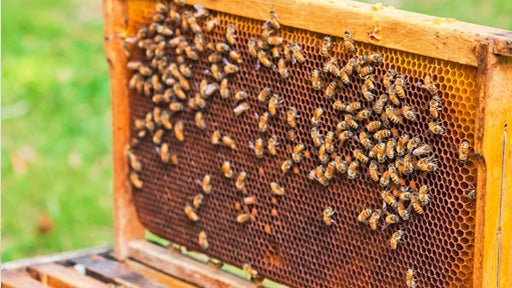

The Waggle Dance: How Saskatchewan Bees Find the Best Flowers
Ever wondered how Saskatchewan bees seem to know exactly where the best flowers are hiding? It’s not luck, no guesswork—it’s a little thing called the waggle dance. Inside the hive, forager bees perform a tiny, rhythmic dance that tells their hive-mates exactly where to find the sweetest nectar. Think of it as part map, part pep talk, and part rave—choreographed by some of nature’s tiniest but most skilled dancers.
BEES: TINY EXPERT NAVIGATORS
Bees are expert navigators with built-in GPS. They use a combination of the sun as a compass, landmark recognition, and their internal “map” of the area to navigate. Even on cloudy days, they can detect polarized light patterns in the sky to stay oriented. This incredible navigation skill helps them find flowers, which is one of the most important jobs they do for the colony. But that’s not all they do.
HOW THE WAGGLE DANCE WORKS
There is a form of special communication unique to honey bees called the waggle dance—yes, that’s the technical term for a very specialized pattern of movement a forager bee will perform for the hive to show them where to find a particularly good foraging spot. It’s definitely not every bee for herself. When she finds a good spot using her natural navigation skills, she returns to the hive to perform a waggle dance showing the others exactly where to go for the good stuff. She moves over the honeycomb in a figure-eight pattern, using vibrations and precise turns to communicate:
-
Direction - the angle of the dance points toward the flowers relative to the sun.
-
Distance - the length of the waggle run indicates how far away the flowers are.
-
Quality - the energy and enthusiasm of the dance show how good the nectar source is.
Think of a combination of a map, a Google review, a dance solo, and a pep talk—all rolled into one tiny but mighty bee performance. But it’s not just one bee foraging and coming back with a single waggle dance for all to follow…
THE DANCE OFF: HOW BEES DECIDE WHERE TO FORAGE
When multiple waggle dances are happening in the hive, the colony essentially debates and votes on the best option. It all unfolds something like this:
-
Forager bees head out to collect nectar. Different scouts may find different flower patches. Each one performs its waggle dance to advertise her find to the hive.
-
Other bees interpret each waggle dance to determine the best source of nectar. This is where enthusiasm and intensity matter. Bees can “read” the quality of the food source based on how vigorous and frequent the dance is. The more enthusiastic the dance, the more convincing it is.
-
Hive bees may start visiting the sites themselves. If more bees start favouring one site over others, the waggle dance for that site gains even more followers (it’s looking like a tiny flash mob, now). This creates a positive feedback loop where the best crowd-voted source of nectar naturally gets the most support within the hive.
-
Eventually, one location wins the majority of support. The swarm then flies out to that chosen site to harvest all they can.
-
The process repeats for each new foraging location.
TINY DANCERS MAKE THE BEST SASKATCHEWAN HONEY
This clever communication system ensures that Saskatchewan bees can efficiently find the best flowers and bring back nectar for the hive. The more nectar they gather, the more delicious honey can be harvested to enjoy year-round. Every drop of honey is a little reminder of the teamwork and precision happening inside the hive. For more about the process of honey production inside the hive, read How Do Bees Make Honey?